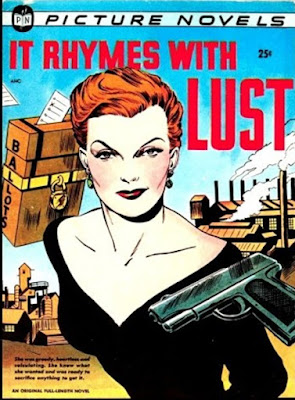This is a pulp that I own and read recently. That’s my copy
in the scan. My guess as to the cover artist is Robert Stanley, but I’m not
certain about that. There are a couple of things about this one I don’t
like—the guy’s hands and arms don’t look quite right to me, and neither does
his holster—but overall it’s an effective cover.I’ve said this many times before and probably will again, but Walt Coburn was
really inconsistent in his work, especially in the second half of the Forties
onwards. But he’s still one of my favorite Western authors because when he’s on
his game, he’s really, really good. “Mail-Order Outlaw” in this issue is one of
his really, really good stories. The cover calls it a novel, but at 16 pages,
even with fairly small print left over from the war years and paper rationing,
it’s more of a novelette. Even so, Coburn manages to give this tale of a young
cowpuncher who falls in with a gang of bank robbers a bit of an epic feeling.
The action is great, the protagonist is very likable, and the villains are
despicable. It’s also more tightly plotted than many of Coburn’s stories, which
tend to sprawl around and get melodramatic. The sense of authenticity is there
as always. No matter how over-the-top Coburn’s plots could get, the characters
and settings always ring true. This is a superb story, one of the best by
Coburn that I’ve read.
I don’t know much about Michael Oblinger, just that he wrote several dozen
stories for various Western pulps. His short story “Hell-on-the-Hoof” starts
out with a horse identifying a killer, but that’s just the opening act in a
very convoluted tale about an accused murderer hunting down the real culprits.
I didn’t think this story was well-written and didn’t care for it.
Since the cover date on pulps was the off-sale date, that means this January
1946 issue of DIME WESTERN was actually on the stands in December 1945.
Accordingly, there’s a Christmas story included in the line-up, the novelette
“Colt Christmas at Bitter Creek” by Rod Patterson. Last year I read a pulp yarn
by Patterson that I enjoyed quite a bit, as well as his novel WHIP HAND, which
I found pretty flat and uninspired. Now that I’ve read this story, I’m starting
to suspect that Patterson was better at less than novel length. “Colt Christmas
at Bitter Creek” is about the showdown between two feuding ranches during a
blizzard. It’s well-written, moves right along, and has a nice hardboiled tone.
I still want to try more of Patterson’s novels, but I’ll be keeping an eye out
for his pulp stories.
Charles Handley is another forgotten pulpster. His story “The Devil’s
Sky-Pilot” is a short-short about an outlaw-turned-preacher—or is he? The twist
ending in this one is pretty predictable, but it still works and the story is
fairly entertaining.
Tom W. Blackburn often wrote stories that weren’t about the usual cowboys,
outlaws, lawmen, etc. The protagonist of the novelette “Battle Call For
Big-Wheelers” is a partner in a freight company located in a Sierra Nevada
mining boomtown. Double-crossed by a man he considered a friend, framed by a
rival for murder, Cole Banning finds himself in a mighty deep hole and
Blackburn just keeps piling more trouble on his head until I honestly wondered
how in the world Banning was going to get out of this mess. But he does, and
although the resolution might have been just a tad too quick and convenient,
this is still a really good story with interesting characters, strong writing,
and plenty of action. Blackburn’s work is nearly always good and this one is no
exception.
John Richard Young wrote a couple of dozen Western and adventure stories for
various pulps in the Forties and Fifties. His story in this issue, “Law of the
Blizzard-Born” is an animal yarn about an old hunter stalking a wolf. This type
of story with little or no dialogue and some, if not most, of the story written
from the point of view of the animal is one that I just have trouble reading. I
wound up skimming this one and didn’t like it.
The novelette that wraps up this issue, “The Phantom Hangman of Yellow Jacket”,
is another mining camp story. Somewhat unusual for a Western pulp, it’s also a
murder mystery as a ruthless vigilante known as The Citizen is killing people
in the camp for no apparent reason. The son of a mine owner who is one
of the victims returns from San Francisco, where he’s been something of a
wastrel, to grow up and get to the bottom of things. As it turns out, this
story isn’t a particularly strong mystery, but it does have a good protagonist
and some nice action as it moves along at a fast pace. The author, Harry F.
Olmsted, is one of my favorites. Olmsted was known to farm out some of his
work, much like Ed Earl Repp, so there’s no way of knowing if some other author
had a hand in this one. The story reads like the other Olmsted stories I’ve
read, but that may be because even on the ghosted stuff, he did a lot of
editing and revising. Regardless of the details, which we’ll likely never know,
this is a solid, entertaining yarn.
Overall, this issue of DIME WESTERN MAGAZINE is quite a mixed bag. There are a
couple of stories I didn’t like, but the others range from good to excellent
and include one of the best Walt Coburn stories I’ve read. So I’d say that if
you have a copy on your shelves, it’s well worth reading.













